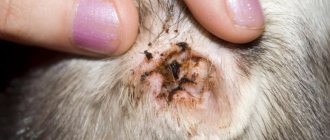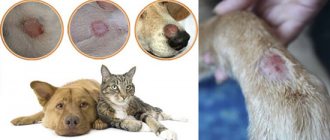Ticks are the main cause of panic among dog owners. Due to the large number of infections carried by parasites, it is important for the health of your four-legged friend to understand the symptoms and main signs that occur after an animal has been bitten by ticks.
Let's look at what to do if a dog is bitten by a tick, look at the symptoms of transmitted diseases and the features of drug treatment, and also talk separately about the main signs of piroplasmosis found in dogs and its treatment.
Features of tick physiology
The most dangerous ticks found on dogs are external parasites that attach themselves to the body from the outside.
Pest insects go through 4 stages of development:
- egg;
- larva;
- nymph;
- adult.
Only one form that is not able to feed on its own is not dangerous.
The most famous representatives of the parasitic family are ixodid ticks, which have:
- proboscis , ending with sharp teeth, allowing you to cut the skin, inject saliva with an anesthetic and suck out blood;
- oval body covered with a chitinous shell of a dark shade;
- 4 pairs of limbs with tiny spines that allow them to hold onto the animal.
Due to their more open bodies, females take on very large sizes after consuming blood. The housing can expand 3 times more than its normal state.
General information
Dogs suffer from ticks most often in the spring season. It is during this period that the incidence of piroplasmosis actively develops. The disease poses a mortal danger to animals. It is carried by ixodid ticks. To protect the animal, it is necessary not to neglect preventive measures and provide high-quality first aid if necessary.
Dogs can pick up a lot of ticks on the street.
In modern medicine, the disease has been well studied. There are high-quality, effective drugs that cope with piroplasmosis. However, there are often fatal cases when medical care is provided to an animal too late. There is a direct relationship between the duration of the disease and the severity of the consequences for the dog’s body. For veterinarian advice on tick control, watch this video:
The threat is not posed by piroplasms, but by the processes occurring in the animal’s body. Parasitism of piroplasms occurs in the blood. Under their influence, red blood cells are destroyed.
Due to the process of decay and release of hemoglobin in a large volume, the functioning of the animal’s internal organs undergoes serious negative changes.
If the disease is not treated, toxic breakdown products are formed. It has a negative effect on the spleen, kidneys, and liver. Severe consequences are associated with brain hypoxia. Dog ticks are carriers of single-celled parasites. Danger comes from ticks of the genus Rhipicephalus and Dermacentor.
First aid for a dog after a tick bite
Ticks are active in spring, attacking weakly protected areas:
- groin;
- hind legs;
- stomach;
- ears.
If your Spitz is bitten by a tick, give him first aid and take him to a veterinary clinic for a more accurate analysis.
What to do if a tick is found on your dog
Carefully inspect the animal for the presence of other parasites. Wear protective gloves and part the fur on risk areas.
Do not try to pull out or crush the insect with your bare hands. In this case, there is a high risk of infection and inflammation.
A tick bite has dangerous consequences, so stock up on the necessary tools and materials and start removing the bloodsucker.
How to properly remove a tick from a dog
You can safely remove a tick from a dog using special Tick Twister tick pliers , which allow you to remove the attached parasite with zero risks. If you don’t have such a tool at hand, you can remove the tick:
- With tweezers. Place the tips in a horizontal position, pry the body of the tick where it enters the skin. Rotate the tweezers with twisting movements, without loosening the grip of the parasite and avoiding pulling straight up.
- Fingers wrapped in a clean cloth or bandage. Grip the body at the base next to the entrance to the dog’s body and begin twisting the insect in either direction. If you managed to remove the tick without consequences, be sure to disinfect the wound with an antiseptic.
When extracting, it is important to avoid the following:
- Do not attempt to use oils, kerosene or gasoline to lubricate the parasite. These liquids block breathing and poison with their vapors, causing the death of the insect with the subsequent release of infection.
- Do not use thread loops. The famous method is dangerous because the severed head gets stuck.
What to do if the tick's head remains in the dog's body
If the head comes off and gets stuck inside the dog's body, then:
- try to find an area with a stuck head (a small black dot that resembles a splinter);
- disinfect and numb the affected area of skin;
- remove it using a calcined needle;
- treat the wound with an antiseptic.
If attempts to find the head fail, then it is necessary to urgently contact a veterinarian to remove the parasite using a surgical incision.
What to do with a tick after removal
After removing the tick, it is taken to a veterinary clinic, where doctors check the parasite for possible infections. This is why it is important to prevent insect damage. Place the tick in a tightly sealed jar or bottle containing cloth or cotton wool moistened with water. After this action, the insect should be transferred to the clinic within 2 days.
If there is no possibility of transmission at the specified time, then crush the parasite between thick layers of paper, scald it or burn it. After death, the tick is disposed of.
What first aid can be given to a dog at home?
Your dog was bitten by a tick, what treatment should you take at home? The first step is to remove the tick from the dog’s body, and the sooner, the lower the likelihood of infection, effort and damage to it.
Important! Do not smear the tick with oil - the tick will begin to suffocate, and in the process the tick (only one that has bitten a dog, of natural size, not loose, easy to pull out without panic) will spill out all its contents, which only promotes infection!
Before this procedure, be sure to treat the bite site and the insect itself with an iodine solution. This way you will muffle the tick, cauterize the wound (bite site), and partially neutralize the tick’s anesthetic toxin (makes the bite site insensitive and severely depresses animals especially not accustomed to it!).
Important! Very often, based on the action of such a toxin, an erroneous diagnosis is made - piroplasma/babesiosis!
You should give your dog loratadine or a similar antihistamine to reduce the allergic reaction. Monitor the temperature, and if after a few hours the dog feels better, then a positive prognosis is quite possible.
If the dog drinks a lot, it can be injected subcutaneously with glucose, sodium chloride, Ringer's solution, etc. On average, 60–70 cc per average dog in the withers area. This will replenish the body's reserves.
IMPORTANT! But if on the second day the situation worsens and the temperature is around 40–41 degrees, you should resort to special drugs - azidine, etc. (if there is no clinic or veterinarian).
This drug should be in the first aid kit of every person who has a dog. This is a bottle of yellow powder. It is diluted: 2.5 cubes of distilled water per bottle.
One cube of the finished solution is injected per 20 kg of the dog’s live weight! We inject under the skin. If necessary, can be repeated after 24–30 hours. But the injection of the drug is given only as a last resort; it is very toxic for young animals, older dogs, post-operative individuals, etc. This is an important condition! Healthy dogs tolerate it very well, regardless of breed. More expensive analogues are considered less severe for the body. Thus, you can be treated for such a disease at home. Remember: without laboratory tests, relapses are possible!
Symptoms and consequences of a tick bite in a dog
Ticks are carriers of dangerous viral diseases, so the consequences of their bite can be very dire. Let's consider what symptoms a dog experiences when bitten by a tick, depending on the disease transmitted.
What diseases can ticks transmit to dogs?
The most dangerous disease transmitted by ixodid ticks is piroplasmosis, so we will consider it in more detail.
Other common ailments include:
I. Ehrlichiosis. Observed in several forms:
- Monotocetary. Infection manifests itself:
- bloody urine;
- anemia;
- weight loss;
- difficulty breathing;
- drop in activity;
- hemorrhages on the cornea and mucous membranes;
- bleeding from the sinuses.
- Granulocytic. This form of the disease is more dangerous in its latent form, leading to severe damage to internal organs and systems. If symptoms are present:
- temperature increase;
- the occurrence of seizures;
- inflammation of the eyelids;
- joint pain.
II. Borreliosis. At the site of the tick bite, inflammation of the adjacent joints is observed, leading to:
- arthritis;
- lameness;
- enlarged lymph nodes;
- inflammatory processes in tissues and blood vessels.
III. Hepatonozoonosis. The progression of a disease that affects leukocytes depends on the condition of the animal, therefore, with high immunity, it may not appear for several years. During illness, the dog:
- feels pain in muscles and joints;
- suffers from lacrimation and purulent discharge;
- experiences weakness and fever.
IV. Bartonellosis. After a tick bite, symptoms may not appear for several years. In such cases, the pet's death becomes unexpected until a medical conclusion is reached. If signs appear, then the sick dog will have:
- anemic;
- pulmonary edema;
- weakness in hind limbs;
- hemorrhages in the eyeballs;
- heart problems;
- sudden weight loss;
- drowsiness;
- inflammation of the eyelids
V. Encephalitis. When a dog is bitten by an encephalitis tick, the following are observed:
- seizures;
- mood changes;
- a sharp rise in temperature.
Note that neurotoxic reactions, characterized by gradual limb failure or brain damage, are more severe in small breeds.
What diseases can ticks transmit to dogs?
In order to protect your pet from various infections carried by blood-sucking parasites, it is necessary to carry out preventive treatments with special means. Ticks can be carriers not only of blood parasitic infections, but also of all kinds of viruses, bacteria and helminths. Tick vaccinations for dogs will help protect your pet from parasites. At the moment of biting through the skin, the ixodid tick injects a specific secretion containing enzymatic substances that act as an anesthetic, as well as allergens and pathogenic microorganisms. The main infections carried by ixodid ticks are:
- Piroplasmosis is a seasonal disease caused by protozoan parasites. The disease is also called babesiosis from the name of the pathogen cells. Babesia infects red blood cells, gradually causing their destruction. Symptoms of pathology differ depending on the type of pathological process - fulminant, acute or chronic. An accurate diagnosis for the presence of piroplasms in the body is made on the basis of laboratory tests in a veterinary clinic. Treatment of diagnosed piroplasmosis includes the use of specific medications, as well as medications that eliminate symptoms. The animal is prescribed special dietary nutrition, cardio and hepatoprotectors, as well as drugs to maintain the functioning of the renal structures.
- Bartonellosis is an infectious disease caused by pathogenic bacterial microorganisms. In addition to damaging red blood cells, Bartonella infects blood macrophages and destroys the walls of blood vessels. After infection, the pathological process can occur without pronounced symptoms and end with the sudden death of the pet. The chronic form of bartonellosis, in the absence of timely treatment, leads to gradual damage to the cellular structures of the myocardium and brain.
- Lyme disease or borreliosis is an infectious process characterized by a chronic course. The disease is transmitted by the bite of an infected tick. Borreliosis can affect not only pets, but also humans. The insidiousness of the disease lies in its long asymptomatic course for 1-3 months from the onset of infection. Characteristic signs of Lyme disease are fever, swelling in the joints, pain and inflammation of the joints, as well as inflammatory processes in the regional lymph nodes. The pet may begin to limp, failure of the kidney structures develops, and in advanced cases, inflammatory processes in the brain tissue are diagnosed. Treatment consists of prescribing a course of broad-spectrum antibiotics. The duration of treatment depends on the degree of neglect of the pathological process.
- Ehrlichiosis is an infection that affects blood cells (monocytes). The danger lies in the ability of pathogenic microorganisms to spread to all organs, affecting the spleen, hepatorenal and lymphatic systems. There are several stages of pathology. An animal with ehrlichiosis develops iron deficiency anemia, and spontaneous hemorrhages are possible.
- Hepatozoonosis is a disease caused by single-celled protozoan parasites that penetrate the bloodstream and infect white blood cells. When performing a blood test, there is a sharp increase in leukocytes in the blood. Hepatozoonosis is treated with antimicrobial drugs. Symptomatic therapy is also prescribed, aimed at speedy regeneration of the body. It is not possible to completely get rid of hepatozoonosis. Therefore, relapses occur quite often.
Signs and symptoms of piroplasmosis
Parasites that carry piroplasma pose the greatest danger to:
- puppies and older dogs;
- animals with chronic diseases;
- purebred pets.
A dog infected with piroplasma ticks will experience the following symptoms:
- a drop in activity accompanied by apathy;
- loss of appetite and refusal of favorite treats;
- hungry vomiting;
- hepatitis;
- pallor or yellowness of mucous membranes;
- diarrhea accompanied by green or bright yellow stools;
- stiffness of movements;
- heart and kidney failure;
- coffee-colored urine caused by the destruction of red blood cells.
If the color of urine changes, the dog must undergo urgent treatment under the guidance of the attending veterinarian. In this case, the countdown goes to the clock.
If treatment for infected dogs begins later than 5 days after the development of the disease, then piroplasmosis is considered incurable and ends in the inevitable death of the animals.
How to tell if your dog has been bitten by a tick
If the dog is not infected, or symptoms of infection have not yet appeared, the presence of a tick on it can only be determined by visual or tactile examination. In the spring and summer, after every walk - in short-haired pets you will immediately notice that the hair is bristling. It is advisable to carefully “stroke” medium- and long-haired dogs with your hands, paying special attention to the areas of the paws, armpits, belly and groin, and chest. Ticks are often found on the dog's neck, where they are almost invisible due to the thick fur. Do this inspection even if the dog has been treated, vaccinated and wears a special collar. No product provides a 100% guarantee, no matter what the manufacturers say.
If you, while brushing your dog, notice a tick separate from its body, it may not have had time to attach itself, but it is also quite likely that it has already sucked blood and fell off. Pay attention to the size of the parasite - a drunk tick swells greatly, often changing its color to purple. Do not throw away the insect - put it in a jar, and preferably take it to the laboratory.
The main symptoms in dogs when bitten and infected by a tick
Here we are talking about cases where infection has definitely occurred. We do not yet know its degree, severity and nature of course. When the disease progresses at lightning speed, it is very difficult to help a dog. Most likely this is fatal. But such cases are not very common. More often there is an acute and slow course of the disease.
Signs:
- The dog has become lethargic, sad, and its behavior in terms of activity and cheerfulness is very different from usual.
- A pitiful whine.
- The dog may roll over onto its back, or press its belly to the floor (this is a reaction to pain in the abdominal area).
- Pale mucous membranes (normal color is pink).
- Dyspnea.
- Chills, tremors.
- Temperature increase.
- Bleeding from the vagina in bitches.
- Staggering when walking.
- Diarrhea and/or vomiting (additional uncommon symptom).
- When the infection progresses significantly, a putrid odor emanates from the dog’s mouth, and the urine becomes dark and mixed with blood.
First aid for a dog with a tick bite
If your dog is bitten by a tick, treatment should not keep you waiting! If possible, the dog should be taken to the clinic at the first signs of infection. But what to do if the disease takes you by surprise somewhere in a village, outside the city, far from veterinary services? In this case, you need to act independently.
If the dog refuses food and food, you must not allow the body to become dehydrated. It is necessary to pour 50-100 ml of water into the dog’s mouth every 30-40 minutes. When vomiting, it will be more effective to give an enema or subcutaneous injection with the same amount of liquid. Thus, the body will receive the missing moisture.
As an emergency treatment, it is necessary to give the dog subcutaneous injections with glucose, vitamins B6 and B12 three times a day. This will help support the body in the fight against the disease, but without special drugs against parasites the dog will not be cured. Self-administration without proper diagnosis can harm the animal.
If the situation is completely hopeless, there is no way to show the dog to a veterinarian, and the condition is accompanied by all obvious symptoms, you can give the dog an injection of Azidine or Veriben, accurately calculating the dosage based on the pet’s weight.
As soon as the situation stabilizes, the first step is to have the dog tested in a laboratory to clarify the diagnosis. It is necessary for the doctor to prescribe complex therapy, since an untreated infection can lead to serious consequences.
Afterwards, there will be a long rehabilitation course aimed at restoring the intestinal microflora, normalizing the activity of vital organs, and, most importantly, strengthening the immune forces of the dog’s body.
The owner's attentive attitude towards his pet will help to promptly detect a threat in the form of a tick and prevent the development of serious complications.
Characteristic symptoms of piroplasmosis in dogs
Owners of barking pets who encounter a tick attack for the first time do not really understand what symptoms to expect when a tick bites a dog and what to do in the future. After all, many signs of piroplasmosis are similar to other canine diseases - distemper, enteritis, leptospirosis, which are not associated with a tick bite and require completely different treatment.
A particular problem is caused by the frequent fact that a dog was bitten by a tick, but was not found on the body, and the owner may not realize for a long time that the deterioration in the condition of his four-legged friend is associated with the tick.
Each dog's infection manifests itself purely individually. The presence of piroplasms in the blood is more difficult to tolerate:
- puppies;
- young dogs;
- chronically ill dogs;
- purebred dogs.
Therefore, an idea of the picture of the disease and what symptoms clearly indicate it will help to begin emergency treatment in time.
- The earliest signs that help alert the owner are a decrease in the dog’s activity. The dog loses its usual playfulness, does not show joy, becomes apathetic, does not ask to go for a walk, and stops carelessly jumping and running.
- The following initial symptoms to suspect piroplasmosis are loss of appetite and refusal not only of food, but also of previously loved and desired delicacies. Nutrition becomes problematic - the dog literally cannot be fed. It is the fact that the dog turns away from the treat that is the SOS signal in the first days of infection!
- Afterwards, on the 3rd - 5th day, more alarming signs of digestion appear - vomiting, often with mucus, because the dog remained hungry all this time, and sometimes diarrhea with a characteristic bright yellow or greenish color of liquid masses. Symptoms of diarrhea are not always observed; the stool may look normal, but the color changes to the indicated one.
- At the same time, you can already notice that the dog is trying to move less, as if this brings him suffering. Her steps are constrained, she prefers to constantly lie away from her master’s eyes and not leave a secluded place. Such symptoms already indicate the progression of the disease.
- But the main symptoms of piroplasmosis are associated with a change in the color of urine - it noticeably darkens, becoming similar to beer or coffee, and may change to a dark brown color. Such symptoms unmistakably indicate piroplasms in the blood that destroy red blood cells, and the need to urgently begin treatment, otherwise irreversible processes may soon kill the dog.
- In healthy adult dogs, the picture may be completely asymptomatic, when the dog dies suddenly for the owners, without showing any special signs of illness beforehand. But an attentive owner, even with the usual behavior of his dog, will notice a change in the suspicious color of the urine, and will guess that this is due to the consequences of a tick bite on his dog.
ATTENTION! If a dog’s urine has changed color, this is not just a reason to contact a veterinarian, but a reason to begin resuscitation measures. On the 5th day of development of the disease, the animal usually dies.
What to do if a tick is not found on the dog, but there are symptoms of piroplasmosis
Very often there is a picture when no tick was found on a dog, and the dog suddenly falls ill, and the symptoms resemble piroplasmosis.
- This phenomenon can be explained by the fact that either when examining the dog, the parasite had not yet had time to attach itself, but was only wandering in the fur in search of a convenient place, or, having had enough, it had already fallen off without being detected.
- Such cases are dangerous because the owners write off the dog’s illness as accidental poisoning or some other disease, and sometimes they begin their own incorrect treatment.
- The absence of a protruding bloodsucker on the dog’s body makes it difficult to link the symptoms with a tick bite on a dog; many people don’t know what to do in such cases. The most important thing here is to pay attention to the color of your urine! If it turns dark, it means piroplasmosis! The diagnosis is confirmed by a blood test taken from the dog at a veterinary clinic.
For your information! To avoid such mistakes, veterinarians advise to palpate the pet not only upon arrival from a walk, but also after 2 - 3 hours, in order to be sure to find the attached parasite.
Feeding a sick animal
To weaken the effect of toxins, it is important not only drug treatment, but also a gentle diet, followed until complete recovery (1-2 months):
- Avoid fatty foods. Feed your dog chicken, oatmeal and beef tenderloin.
- Avoid repeated reheating. Serve warm food, prepared exactly at the time of feeding.
- Provide your pet with enough fresh and clean water . To boost immunity, fortified rosehip decoctions are suitable.
Try to avoid excessive physical activity. The maximum load during treatment is leisurely walks over a short distance.
Preventive measures
You can reduce the risk of a tick bite if you use preventive measures - collars, spray, drops on the withers. The mechanism of action of the drugs is identical - the active substance accumulates in the pet’s skin, repelling parasites, as well as poisoning those who try to bite the dog. The only difference is in the methods of applying the drug:
- The collar does not require specific application measures; it is enough to put it on the animal. Due to the high concentration of the substance in the neck area, the animal's fur under the collar may come out. In this case, you will have to refuse to use the product.
- Drops against fleas and ticks are applied to the withers. Absorbed into the skin, they are evenly distributed throughout the animal’s body. The advantage of the drug is that it cannot be licked off.
- The spray is not suitable for dogs with thick fur. It must be sprayed onto the animal's skin, lifting the fur. After application, do not allow the dog to lick itself. The spray is stronger than drops, but the risk of side effects for the dog is higher.
To minimize the risk of contracting infectious diseases, you can vaccinate your pet. Veterinary clinics provide vaccines against diseases such as piroplasmosis and tick-borne encephalitis. It is better not to neglect this opportunity, since it will take more time and effort to treat the dog than to vaccinate it in a timely manner.
Ticks are an unpleasant but inevitable part of a dog's life. You can reduce the risk of a bite if you do not let your dog frolic in thick grass, exclude its contact with stray animals, and also treat it with drops or spray.
Prevention of tick bites in dogs
To protect your pet, use special antiparasitic drugs to minimize the risk of infection.
To prevent ticks in dogs, the following are recommended:
- drops and sprays;
- collars;
- vaccines.
Let's take a closer look at them.
Drops and sprays
The obvious disadvantage of these anti-tick products is a gradual decrease in effectiveness. It is also worth noting that:
- if you bathe frequently, the dog will have to be treated after each wash; — owners of long-haired pets will have to use twice as much product; — the spray will need to be sprayed not only on the withers, but also on other open areas of the body.
Among the most popular brands, veterinarians note:
- advantix, leopard, stronghold, mr. bruno, frontline - drops;
- Bolfo, Hartz, Frontline, Mr. Bruno - sprays.
Collars
Collars cause frequent allergic reactions, accompanied by local hair loss, and are contraindicated for:
- aged <2 months;
- lactation;
- pregnancy;
- chronic diseases or weakened immunity.
Unlike sprays and drops, the collar can last for over six months, so if your pet has no contraindications, then purchase one of the following brands:
- beafar;
- kiltix;
- foresto.
Vaccine
To protect against piroplasmosis, veterinarians advise using one of the following vaccines:
- pyrodog;
- nobivac pyro.
At the appointment, doctors should explain how to use the vaccine at home. Usually, after administration of the drug, a month's break is taken, followed by revaccination.
Subsequent vaccinations depend on the place of residence and the concentration of ticks, but the minimum break should be at least six months.
Please note that vaccination does not provide 100% protection against viruses, but it does provide a milder course of the disease.
How to remove a tick - video
We invite you to watch a video where the veterinarian will tell you about ticks and the symptoms of their bite in dogs, how to protect your dog from ticks, what anti-tick collars and drops to use for your dog, as well as what to do if your dog is bitten by a tick .
How do you protect your dog from tick attacks? Which drugs, in your opinion, are the most effective? How did you treat your pet after being bitten by an infected tick? Share your experience in the comments.
Share
Leave a review
What signs can you use to determine if your pet has ticks?
Once filled with blood, it is not difficult to find a tick on the body. The parasite grows to the size of a large bean, changing its usual color to reddish.
The manifested symptoms are divided into 3 large groups:
- Local reactions. After removing the tick, the dog appears: a. edema; b. redness; c. increase in local temperature; d. itching and pain on the affected area of the skin; e. purulent inflammation.
- Neurotoxic reactions causing tick paralysis. The dog has: a. gradual failure of the limbs, starting with the hind legs; b. impaired swallowing reflex (dysphagia); c. decreased volume and audibility of barking (dysphonia); d. shortness of breath and suffocation.
- General reactions. Infected animal: a. loses activity and appetite; b. suffers from bowel problems; c. itches often; d. has problems with coordination.
Treatment methods
To clarify what kind of infection has struck the pet, blood tests are submitted to the laboratory. The simplest piroplasmosis causes the destruction of red blood cells in the blood.
Hemoglobin disintegrates and the activity of internal organic systems is disrupted. If a dog is bitten by a tick, the doctor will tell you what the owner needs to do.
If piroplasmosis is diagnosed, treatment for dogs includes:
- injections of special drugs. Antiparasitic agents Veriben, Piro-stop, Imizol, Berenil, Azidine are used.
- To alkalize urine, sodium bicarbonate is administered intravenously. It prevents hemoglobin from blocking the kidney channels.
- Soldering with soda solution. The medicine Blemaren is also used.
- Taking diuretics.
- Introduction of glucose, which tones the body.
- Introduction of vitamins.
Veriben is a drug that is widely used in the treatment of protozoal and infectious diseases of animals. It is used for the development of babesiosis, piroplasmosis, and trypanosomiasis.
The product is available in powder form for injection. It is recommended to administer the drug at the first signs of mite infestation.
Azidine is also used against piroplasmosis. It contains antibacterial substances that kill infection. The medicine is available in powder form for injection. If the dog weighs 15 kg, the finished solution should be administered in 0.5 ml.
To reduce the temperature, the pet is injected subcutaneously with Dexamethasone. If the dog weighs 15 kg, the dosage of the drug should not exceed 0.5 ml.
To enhance the functioning of the immune system and restore cells, it is recommended to use the drug Catazal. The product improves metabolic processes in the body and contains important vitamins.
In case of vomiting and diarrhea, dehydration and intoxication of the body are eliminated with droppers. Solutions of Sodium Chloride, Reamberin, Ringer, and Glucose are administered. The diuretic Furosemide is prescribed. This measure helps to quickly remove toxins from the infected body.
Encephalitis is also treated with drugs that can affect the central nervous system.
Be sure to take glucose, antiparasitic vaccines and medications to relieve acute inflammation.
With encephalitis, the nervous system may lose some functions even when taking an effective drug.
Features of puppy therapy
The body of a young dog is extremely sensitive to various types of infections, so the puppy’s treatment must be qualified.
It is difficult for puppies to protect themselves from ticks, and dog illness requires a lot of attention from both doctors and the owner, because when a tick bites a puppy, it can infect a dangerous infection. At the first sign, the puppy should be taken to the veterinarian.
The puppy needs to be given water and sweet tea regularly. The liquid is poured in a teaspoon every 30 minutes. A minimal amount of liquid will not cause vomiting and will be completely absorbed into the walls of the stomach. Medications are administered intravenously to the puppy to eliminate dehydration.
To support the animal's immunity, the animal is given rosehip decoctions to drink throughout the day. The doctor prescribes vitamin injections and plant-based drops.
After recovery, it is recommended to limit the dog’s physical activity. Walks should be short in duration.
The pet needs more rest, since piroplasmosis weakens the functioning of organs. The dog's immune system is in poor condition after illness. It is important to prevent your pet from hypothermia or overheating.
The dog needs an enhanced diet. Rehabilitation usually takes a long time. It is important to normalize the activity of the intestines, stomach, heart, and nervous system.
Are ticks on dogs dangerous for people?
Diseases transmitted by ticks are dangerous not only for four-legged friends, but also for their owners, so any interaction with an infected animal must be accompanied by special protective equipment.
The most dangerous for humans are:
- encephalitis ticks;
- ticks that transmit Lyme disease (borreliosis).
Ticks are dangerous not only for dogs, but also for their owners. To protect against parasites, do not forget about preventive measures and try to wear special overalls on your pet. In this case, it will be more difficult for the insect to get to its favorite places.
Check your pet after every walk, especially during periods of tick concentration, and do not hesitate to contact a veterinarian if you notice any alarming symptoms.
General information about ticks
Actually, ticks are insects and their diversity is very great. Ticks (lat. Acari) are arthropods from the class of arachnids. There are more than 144 thousand species, including 54 thousand living ones, the rest are fossils. At the same time, their body structure differs from spiders, although similarities can be traced. Sizes range from 0.2 (micro dust mites) to 10 mm. But our attention will be focused on ticks that cause vector-borne blood diseases in dogs - the genera Ixodidae, Dermacentor, Rhipicephalus and Hymaiyoma. Actually, the parasite itself is dangerous only because it affects the skin and the bite site swells greatly (wounds form and take a long time to heal) - the anesthetic poison is triggered. A severe reaction may develop to this poison. For example, like this:
- lethargic dog after a tick bite,
- the animal is oppressed,
- food refusal occurs
- an allergic reaction occurs
- the temperature rises (especially with the first bites in life).
But all this will pass over time, as soon as the body overcomes the toxin. The more bites, the stronger and more pronounced the effect of the toxic substance in the dog’s body. This toxin makes the skin numb, and the tick thus protects itself from being removed by an animal’s paw or pulled out by teeth, etc. - the pet does not feel it! Trouble comes if the tick has been infected with Babesia/Piroplasma or other protozoal pathogens. It is they that enter the bloodstream during a bite and multiply there, causing serious illnesses and consequences.











